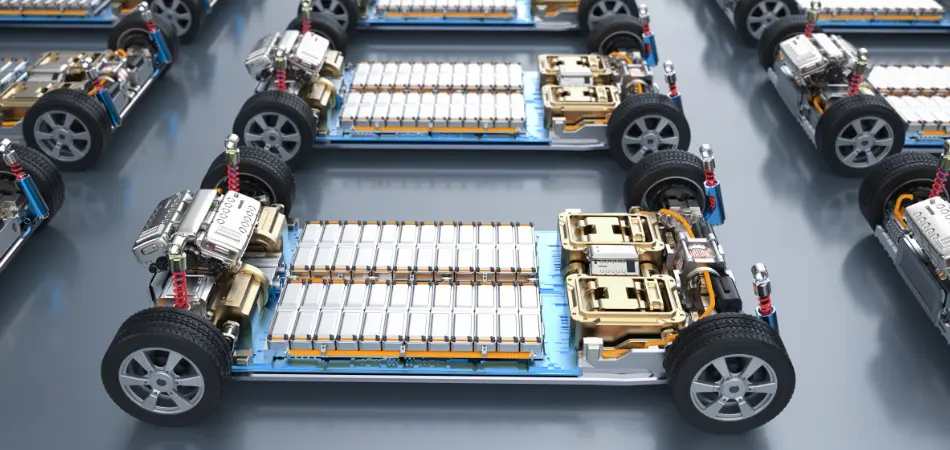Rechargeable Lithium-ion Battery Safety: Tips for Professionals

Lithium-ion batteries power everything from smartphones and laptops to electric cars, making them indispensable in modern life.
Yet, they have their downside.
- They can catch fire due to “thermal runaway,” where a battery’s temperature rises uncontrollably.
- Their flammable electrolyte fluid can also ignite or explode.
- During failure, they can release highly toxic gases.
- Physical damage or design flaws can cause instability, increasing the likelihood of malfunctioning.
Safer battery technology is under development, but until then, we have an uneasy partnership with these energy-dense and potentially volatile gadgets. If you’re a professional working with lithium-ion batteries, you should recognize the potential hazards and follow proper safety precautions.
Tips for Handling Lithium-ion Batteries Safely
1: Battery Chemistry
Lithium-ion batteries have an anode, cathode, separator, and electrolyte fluid. Understanding how battery chemistry works can help you identify potential risks and handle them safely.
For instance:
- Lithium is highly reactive in its pure form and can ignite when exposed to air or moisture.
- The electrolyte fluid is flammable and can be harmful if ingested or in contact with skin.
- The separator is a thin, porous membrane that keeps the anode and cathode from touching. If damaged, it can cause a short circuit.
2: Storage & Transportation
Lithium-ion batteries can be exposed to extreme conditions like temperature changes, pressure variations, or physical damage during storage or transportation. To ensure safety:
- Store them in a cool, dry place with temperatures between 15-25°C (59-77°F).
- Avoid stacking or dropping them, which can damage the protective casing and lead to fires.
- Use insulated packaging during transport to protect against impact damage.
- Never remove warning labels.
- Control access to batteries so that no one handles them without proper training.
- Never allow open flames near the cells, including lit cigarettes.
3: Charging Practices
Improperly charging lithium-ion batteries is one of the leading causes of battery failures. Tips to avoid this include:
- Use the correct charger for your device or battery.
- Avoid overcharging. Unplug your device when it’s fully charged.
- Don’t charge batteries near flammable materials or on unstable surfaces.
- Never attempt to charge a frozen, damaged, or expired battery.
- Turn the charger off when connecting the leads to the battery.
- Ensure positive leads are connected to positive terminals and negative leads to negative terminals.
- Secure the charging leads before turning on the charger. Never adjust leads when the charger is on.
- Switch the charger off before disconnecting the leads.
- Never allow the uninsulated parts to touch each other or metalwork when storing the charging leads.
4: Disposal
Improper disposal of lithium-ion batteries can be hazardous to the environment and human health. It’s also illegal in many areas.
- Completely discharge the battery before disposal.
- Tape the terminals with non-conductive tape to prevent short circuits during transport.
- Check local regulations for proper disposal methods (e.g., recycling centers or designated drop-off locations).
Rechargeable Lead-Acid Battery Safety
The following tips apply only to lead-acid batteries.
- Keep batteries in a well-ventilated area. Lead-acid batteries produce hydrogen gas, which needs ventilation to prevent explosion risks.
- Rinse batteries and terminals before charging to eliminate acid residue.
- When charging a battery, open the lid or doors to the storage compartment to prevent gas buildup.
- Always use extreme caution when handling sulfuric acid electrolytes.
- Before charging a vented battery, make sure the electrolyte level is just above the tops of the plates in the cells. Top it up if it’s too low.
- Let vented batteries stand for 20 minutes after disconnecting the charger.
FAQs About Rechargeable Battery Safety
Q: How can I tell if a lithium-ion battery is damaged or at risk of failure?
Watch for signs like bulging, leaking, or discoloration on the battery casing. If you notice any of these symptoms, stop using the battery.
Q: Can I use a non-branded charger for my rechargeable batteries?
It’s best to use chargers designed for your device or battery to avoid compatibility issues and reduce the risk of overcharging.
Q: Are there any specific storage conditions for lithium-ion batteries?
Lithium-ion batteries should be stored in a cool, dry place between 15 °C and 25°C (59-77°F). They should also be kept away from direct sunlight and moisture.
Q: What should I do if my lithium-ion battery catches fire?
If available, use a Class D fire extinguisher. If not, use sand or a metal fire blanket to smother the flames. Avoid using water, which reacts exothermically with lithium.
Q: Is it safe to keep a lithium-ion battery installed in a device not used for long periods?
If the device is stored for a long period, it’s best to remove the battery. This can reduce the risk of degradation and potential issues associated with self-discharge or unintentional charging cycles.
Q: Can lithium-ion batteries be submerged in water?
Never submerge lithium-ion batteries in water due to the reactive nature of lithium. Avoid exposing them to liquids.
Q: What are some signs that a charger is unsafe to use?
Signs of an unsafe charger include frayed or exposed wires, excessive heat during charging, and compatibility issues with your device. Always inspect your charger for damage before use.
Q: How can over-discharging affect lithium-ion batteries?
Over-discharging can damage cells and reduce capacity. To prevent this, stop using the battery before it’s completely drained and recharge it to an appropriate level.
Q: Are there any special considerations for traveling with lithium-ion batteries?
When traveling by air, keep lithium-ion batteries in your carry-on luggage rather than checked baggage. Ensure they’re protected from damage, and pack them individually in protective cases or bags to prevent short circuits.
2 Comments
Submit a Comment
More Articles

Thanks! This is very informative blog.
you didn’t cover corrosion and if the cable is corroded but doesn’t show upon spraying ?? is that a worry?